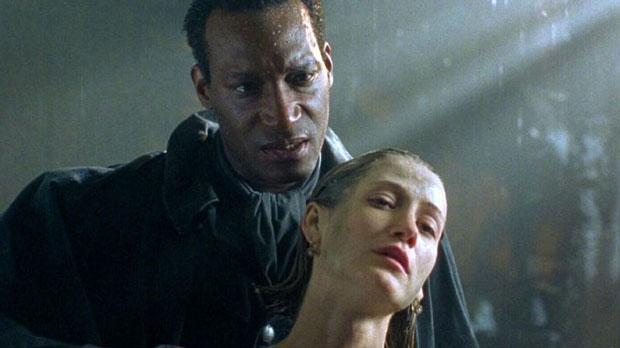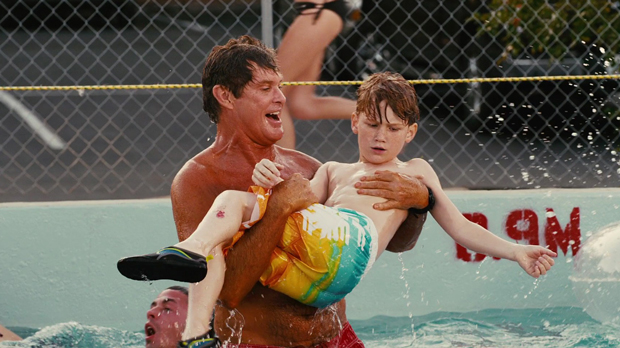 Candyman: Farewell to the Flesh (1995) Gramercy/Horror RT: 95 minutes Rated R (violence and gore, some sexuality, language) Director: Bill Condon Screenplay: Rand Ravich and Mark Kruger Music: Philip Glass Cinematography: Tobias A. Schliessler Release date: March 17, 1995 (US) Cast: Tony Todd, Kelly Rowan, William O’Leary, Bill Nunn, Matt Clark, David Gianopoulos, Fay Hauser, Joshua Gibran Mayweather, Timothy Carhart, Veronica Cartwright, Caroline Barclay, Michael Bergeron, Brianna Blanchard, Clotiel Bordeltier, Russell Buchanan (voice). Box Office: $13.9M (US)
Candyman: Farewell to the Flesh (1995) Gramercy/Horror RT: 95 minutes Rated R (violence and gore, some sexuality, language) Director: Bill Condon Screenplay: Rand Ravich and Mark Kruger Music: Philip Glass Cinematography: Tobias A. Schliessler Release date: March 17, 1995 (US) Cast: Tony Todd, Kelly Rowan, William O’Leary, Bill Nunn, Matt Clark, David Gianopoulos, Fay Hauser, Joshua Gibran Mayweather, Timothy Carhart, Veronica Cartwright, Caroline Barclay, Michael Bergeron, Brianna Blanchard, Clotiel Bordeltier, Russell Buchanan (voice). Box Office: $13.9M (US)
Rating: ***
The horror sequel Candyman: Farewell to the Flesh is a textbook example of the Law of Diminishing Returns. In other words, it’s not as good as the first movie. It’s not surprising; sequels generally aren’t as good as their predecessors. The good news is the second Candyman movie doesn’t suck either. It has its merits, but it doesn’t rise to the level of a horror classic like the original did. To its credit, it’s consistently pretty good.
Directed by Bill Condon (Gods and Monsters), the action of Candyman: Farewell to the Flesh has been moved from Chicago to New Orleans on the eve of Mardi Gras. It opens with the brutal murder of Professor Phillip Purcell (Culkin, no relation to Macaulay), resident Candyman expert and lone holdover character from the first movie (except for you-know-who). It occurs just moments after a violent confrontation with Ethan (O’Leary, Hot Shots!) who holds Purcell responsible for his father’s murder. His father was investigating the Candyman legend when he was killed in a very familiar manner.
Ethan is arrested for Purcell’s murder and held at the local police station while his schoolteacher sister Annie (Rowan, The Gate) tries to prove his innocence. Meanwhile, one of her students, preacher’s son Matthew (Mayweather, Camp Nowhere), claims that he’s seen Candyman which freaks out his classmates. Annie, in an act of astonishing stupidity, attempts to prove he’s not real by saying his name five times in a mirror. Of course, she ends up summoning the malevolent entity which brings about another series of killings starting with her husband Paul (Carhart, Beverly Hills Cop III). Like Helen Lyle before her, Annie goes down the Candyman rabbit hole as she tries to find a way to stop him.
The writers have changed Candyman’s background slightly, but the basic story is still the same. In life, he was the son of a slave who made the mistake of falling in love with a wealthy white girl and paid for it with his life. After his horrific death at the hands of a lynch mob, his soul was contained in a mirror belonging to the girl who ran off to have their baby. That was more than a century ago. Now he’s back (again) and targeting Annie’s family for reasons you’ll probably be able to guess early on.
Tony Todd once again shows that he’s the perfect choice to play Candyman, a misunderstood monster who kills with a purpose. He brings both class and menace to the character, not once playing it for laughs or camp value. He is one scary mother! Rowan is good as the heroine of the story. Alternately tough and terrified, her fear is palpable as she draws closer to the truth about the urban legend that turns out to be all too real. Veronica Cartwright (Alien) adds a note of class as the Southern matriarch best described as a campy version of Amanda Wingfield from The Glass Menagerie.
The screenplay by Rand Ravich and Mark Kruger stumbles around in the dark looking for the right narrative path. Candyman: Farewell to the Flesh isn’t as self-assured as its predecessor. It has atmosphere aplenty, but little in the way of scares. The setting, New Orleans during Mardi Gras time, is close to brilliant. The Louisiana town (aka “The Big Easy”) is a bastion of sin in the days leading up to Lent and atonement for one’s sins. What better place for the personification of evil to lurk? But is Candyman evil? I’d say he does evil things, but he’s not necessarily evil. He’s angry and vindictive. A terrible wrong was done to him and he wants payback. Like I said, Candyman is more of a tragic figure than a mad slasher.
The score by Philip Glass is great his second time at bat. The man is a talented composer; he strikes all the right chords with his work here. The cinematography by Tobias A. Schliessler is also an asset. There’s plenty to like about Candyman: Farewell to the Flesh even if it doesn’t measure up to the original. I hoped that it would when I saw it at an advance screening. Deep down, I knew that it wouldn’t. That it’s pretty good is something of a blessing. A lot of horror sequels can’t even manage that. It has enough good points to make it worth a viewing.




